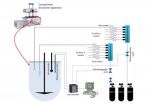(Press-News.org) RIVERSIDE, Calif. — Do you want information on Viagra or ibuprofen? Check out general social networks such as Twitter and Pinterest. Interested in sleep disorders or depression? You're better off going to specialized health social networks such as WebMD or drugs.com.
That is one of the findings of a just published paper, "Pharmaceutical Drugs Chatter on Online Social Networks," based on an analysis of more than 1 million drug-related posts, by a team of researchers at the University of California, Riverside's Bourns College of Engineering and Zhejiang University in China.
The findings have implications for a wide range of stakeholders. Healthcare providers have more knowledge when recommending social network sites to their patients, or to create new forums for particular health conditions or drugs, which are important given the increasing engagement of patients in their health management.
Also, health care marketing professionals may better focus their resources given a drug. And, researchers of healthcare content in social networks can use the results when selecting data sources.
The findings include:
Posts to health social networks, such as Web MD and drugs.com, were about twice as likely to have negative sentiment compared to those in general social networks, such as Twitter and Google+.
The same group of drugs are popular across all analyzed general social networks, while different drugs are popular in health social networks.
Posts about psychotherapeutic agents, such as Abilify and Cymbalta, are about five times more common on health social networks, while posts about genitourinary tract agents, such as Viagra and Cialis, are 16 times more common in general social networks.
The paper, soon to be published in the Journal of Biomedical Informatics, was written by Vagelis Hristidis, an associate professor in the computer science and engineering department at UC Riverside, Matthew T. Wiley, a graduate student working with Hristidis; Kevin M. Esterling, a professor of political science at UC Riverside; and Canghong Jin, a visiting graduate student from Zhejiang University in China.
The researchers identified 10 social networks to study and charted whether they: (1) were health focused or general; (2) moderated; (3) required registration; (4) in the form of question and answer.
The general social networks studied were Twitter, Google+ and Pinterest. (Facebook was not because its data is not public). The health social networks were DailyStrength, Drugs.com, DrugLib.com, EverydayHealth.com, MediGuard.org, WebMD and Medications.com.
The researchers obtained a list of the 200 most commonly prescribed drugs and narrowed it down to 122 by eliminating such things as variants of the same drug but with different strengths.
Meanwhile, they created tools that allowed them to collect references to the drugs from the social network sites. The tools included filters that eliminated such things as duplicate posts and non-English posts. All data was collected in accordance with the terms of use of each social network. Messages that could be considered spam were not removed because the definition of spam is subjective.
The earliest collected data from the different sites was generated anywhere from 2001 to 2012, depending on when the site was created. The data collection process ended in early 2013.
Data collection from the different sites started anywhere from 2001 to 2012, depending on when the site was created. Data collection ended in early 2013.
The posts were analyzed in three ways. One, whether they were positive, negative or objective. Two, by breaking them into six drug categories: coagulation modifiers, genitourinary tract agents, nutritional products, cardiovascular agents, psychotherapeutic agents and others. Three, by detecting mentions of five types of medical concepts: anatomy, physiology, procedures, chemicals and drugs and disorders.
The researchers also studied differences in the discussions' content on the social networks based on whether there was moderation, registration required or a question-and-answer format.
Additional findings include:
There was an 87 percent increase in discussion of psychotherapeutic agents on non-moderated health social networks. Conversely, gastrointestinal agents, hormones, anti-infectives, and respiratory agents all increased on moderated health social networks.
There was a 42 percent decrease in discussion of central nervous system agents on health networks that require registration. Conversely, health social networks that require registration had a 225 percent increase in posts about respiratory agents.
Health social networks that have a question-and-answer format have an increase in posts related to coagulation modifiers (243 percent) and metabolic agents (63 percent), whereas non-question-and-answer health social networks had an increase in posts related to anti-infectives (354 percent) and psychotherapeutic agents (47 percent).
A future paper will look at the demographics of the people who post to the health social networks. Further in the future, Hristidis plans to study sites that allow patients to rate doctors.
INFORMATION:
The research was supported by the National Science Foundation grant IIS-1216007.
Where to get Viagra news? (Really, this isn't spam)
Researchers study prescription drug posts on social networks to help health care providers find best sources for information
2014-03-31
ELSE PRESS RELEASES FROM THIS DATE:
Biolimus still comparable to everolimus in year 2 of stent match-up
2014-03-31
WASHINGTON (March 31, 2014) — A new stent covered with biodegradable coating continues to show statistical equivalence to Japan's market leader in cumulative second-year data and subgroup analyses, according to research from the NEXT trial presented at the American College of Cardiology's 63rd Annual Scientific Session. NEXT is the largest head-to-head randomized study of these two stents – the novel biolimus-releasing model with the degradable coating (BES) and the everolimus-releasing standard with a durable polymer (EES).
Polymer coatings contain the drugs in drug-eluting ...
Tested a drug that strengthens the analgesic effect of opioids without increasing constipation
2014-03-31
Scientists from the University of Granada have taken part, alongside the Esteve laboratory, in the development of a new drug that multiplies the analgesic effect of opioids (drugs for treating intense pain), without increasing constipation, one of the most common side-effects of these drugs, among which is morphine.
This important scientific breakthrough has been published in The Journal of Pharmacology and Experimental Therapeutics, and has been chosen as its outstanding article in the month of January. So far, the University of Granada researchers have published the ...
Researchers develop device that simulates gastro-intestinal tract
2014-03-31
A breakthrough in drug testing developed by a University of Huddersfield lecturer could lead to cheaper, more effective medicines. Dr Hamid Merchant is a member of the team that has created a device which accurately simulates the gastro-intestinal tract and how it absorbs medication. This means that the cost of clinical trials could be greatly reduced, with savings passed on to customers.
Dr Merchant has joined the University as a Senior Lecturer in Pharmaceutics. Previously a postdoctoral fellow at University College London (UCL), he has extensive research experience, ...
Certain genetic variants may identify patients at higher risk of bladder cancer recurrence
2014-03-31
While patients diagnosed with bladder cancer usually face a favorable prognosis, many experience recurrence after treatment. Because frequent, painful screenings are needed to identify recurrences, the ablility to identify patients at high risk of recurrent cancer could help to improve quality of life for all bladder cancer patients.
A new study published in BJU International, "Genetic polymorphisms modify bladder cancer recurrence and survival in a U.S. population-based prognostic study," suggests that certain inherited DNA sequences may affect a bladder cancer patient's ...
Heparin more effective than bivalirudin in patients during emergency heart procedure
2014-03-31
WASHINGTON (March 31, 2014) — In a comparison of two blood-thinning medications, heparin was associated with significantly fewer major cardiovascular events at 28 days than bivalirudin in patients receiving primary percutaneous coronary intervention after a heart attack, according to research presented at the American College of Cardiology's 63rd Annual Scientific Session.
The single-center, open label trial enrolled 1,829 patients with suspected heart attack who received a coronary angiography, an imaging test to see how blood flows through the heart. Patients were randomized ...
Anti-anxiety drugs and sleeping pills linked to risk of death
2014-03-31
Anti-anxiety drugs and sleeping pills have been linked to an increased risk of death, according to new research from the University of Warwick.
The large study, published in BMJ, shows that several anxiolytic (anti-anxiety) drugs or hypnotic drugs (sleeping pills) are associated with a doubling in the risk of mortality.
Although these findings are based on routine data and need to be interpreted cautiously, the researchers recommended that a greater understanding of their impact is essential.
Professor Scott Weich, Professor of
Psychiatry at the University of ...
Drug-eluting stents demonstrate better outcomes after 1 year than bare metal stents
2014-03-31
WASHINGTON (March 31, 2014) — Use of drug-eluting stents is associated with a lower risk of major cardiovascular events at one year compared to bare metal stents when followed by an individualized course of blood-thinning medication among patients previously thought to be uncertain candidates for drug-eluting stents due to their heightened risk of bleeding or blood clots, according to research presented at the American College of Cardiology's 63rd Annual Scientific Session.
Positive study findings for patients receiving a shorter than currently recommended course of ...
Never say never in the nano-world
2014-03-31
This news release is available in German.
Objects with sizes in the nanometer range, such as the molecular building blocks of living cells or nanotechnological devices, are continuously exposed to random collisions with surrounding molecules. In such fluctuating environments the fundamental laws of thermodynamics that govern our macroscopic world need to be rewritten. An international team of researchers from Barcelona, Zurich and Vienna found that a nanoparticle trapped with laser light temporarily violates the famous second law of thermodynamics, something that ...
New human trial shows stem cells are effective for failing hearts
2014-03-31
WASHINGTON (March 31, 2014) — Patients with severe ischemic heart disease and heart failure can benefit from a new treatment in which stem cells found in bone marrow are injected directly into the heart muscle, according to research presented at the American College of Cardiology's 63rd Annual Scientific Session.
"Our results show that this stem cell treatment is safe and it improves heart function when compared to placebo," said Anders Bruun Mathiasen, M.D., research fellow in the Cardiac Catherization Lab at Rigshospitalet University Hospital Copenhagen, and lead investigator ...
Real-world heart procedure results consistent with scientific research
2014-03-31
WASHINGTON (March 31, 2014) — The first one-year outcomes data of transcatheter heart valve replacement (TAVR) in nearly all U.S. patients undergoing this procedure shows that real-world outcomes are comparable to or slightly better than those found in clinical trials, according to registry data presented at the American College of Cardiology's 63rd Annual Scientific Session. However, specific baseline characteristics of patients undergoing TAVR are associated with differing degrees of death and survival and may be important considerations for patient counseling and shared ...
LAST 30 PRESS RELEASES:
First ‘Bible map’ published 500 years ago still influences how we think about borders
Why metabolism matters in Fanconi anemia
Caribbean rainfall driven by shifting long-term patterns in the Atlantic high-pressure system, study finds
Potential treatment to bypass resistance in deadly childhood cancer
RSV vaccines could offer protection against asthma
Group 13 elements: the lucky number for sustainable redox agents?
Africa’s forests have switched from absorbing to emitting carbon, new study finds
Scientists develop plastics that can break down, tackling pollution
What is that dog taking? CBD supplements could make dogs less aggressive over time, study finds
Reducing human effort in rating software
Robots that rethink: A SMU project on self-adaptive embodied AI
Collaborating for improved governance
The 'black box' of nursing talent’s ebb and flow
Leading global tax research from Singapore: The strategic partnership between SMU and the Tax Academy of Singapore
SMU and South Korea to create seminal AI deepfake detection tool
Strengthening international scientific collaboration: Diamond to host SESAME delegation from Jordan
Air pollution may reduce health benefits of exercise
Ancient DNA reveals a North African origin and late dispersal of domestic cats
Inhibiting a master regulator of aging regenerates joint cartilage in mice
Metronome-trained monkeys can tap to the beat of human music
Platform-independent experiment shows tweaking X’s feed can alter political attitudes
Satellite data reveal the seasonal dynamics and vulnerabilities of Earth’s glaciers
Social media research tool can lower political temperature. It could also lead to more user control over algorithms.
Bird flu viruses are resistant to fever, making them a major threat to humans
Study: New protocol for Treg expansion uses targeted immunotherapy to reduce transplant complications
Psychology: Instagram users overestimate social media addiction
Climate change: Major droughts linked to ancient Indus Valley Civilization’s collapse
Hematological and biochemical serum markers in breast cancer: Diagnostic, therapeutic, and prognostic significance
Towards integrated data model for next-generation bridge maintenance
Pusan National University researchers identify potential new second-line option for advanced biliary tract cancer
[Press-News.org] Where to get Viagra news? (Really, this isn't spam)Researchers study prescription drug posts on social networks to help health care providers find best sources for information


